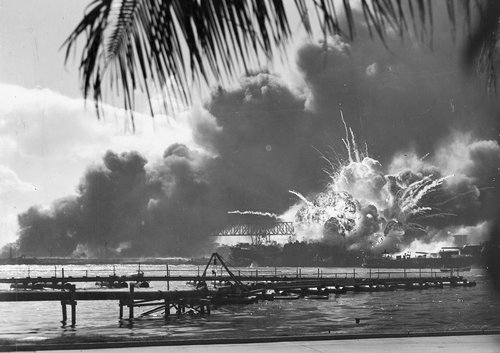
By Sarah Johnston
This week sees the 75th anniversary of the Japanese attack on the US naval base at Pearl Harbor in Hawaii. The attack brought the United States into World War II and brought the war to the Pacific and New Zealand’s back yard.

Photograph taken from a Japanese plane during the attack. (Wikimedia Commons )
You can hear me talking to RNZ’s Jesse Mulligan about recordings from the sound archives of Nga Taonga Sound & Vision about this historic event here – or you can read more here and listen to the recordings in full at the links below.
At the time of the bombing the United States and Japan were actively in peace talks over Japan’s war with China, with Japanese officials in Washington D.C. for negotiations. However, it soon became clear that this air attack had been carefully planned for months, so the outrage felt by the American public at the Japanese deception was immense.
The day after the attack, President Roosevelt addressed the United States Congress and the American people in this historic radio broadcast. Ngā Taonga Sound & Vision holds a recording made in Wellington at the time, from the shortwave radio broadcast, but this version supplied later – directly from the United States – is better quality audio.
President Franklin Roosevelt declares the United States is at war with Japan, 8 Dec 1941.(151134)

USS Arizona burning after the attack. (Wikimedia Commons )
The following recording on this compilation tape, is an eye witness account by a US Air Force serviceman, Lieutenant Wallace, who was at Hickham Field airforce base next door to Pearl Harbor. He describes his very brief experience of active warfare.
Pearl Harbour recollection by a US serviceman (151134 )
Another eye witness account of the attack – this time from a civilian perspective – was recorded here in New Zealand a couple of months later, in early 1942, by Thomas Matthews. He was an Englishman, a violinist with the London Philharmonic Orchestra. He was onboard a passenger ship sailing into Honolulu on the fateful morning, on his way to take up a new role in Singapore (which was still a British colony). As he explained to New Zealand radio listeners, at first he and the rest of the passengers thought they were watching military manoeuvres.
'Attack on Pearl Harbour' - Eyewitness Account of Thomas Matthews, 1942.
As the Japanese were also advancing towards Singapore, it seems Mr Matthews changed his plans, and came to New Zealand instead. We can see by newspaper reports that he had some engagements playing with orchestras here and he gave some radio broadcast performances in Auckland in 1942.

USS Shaw exploding - Pearl Harbor, 07 December 1941. (Wikimedia Commons )
The attack on Pearl Harbor in 1941 not only meant the United States was now at war, but it marked the arrival of the war in the Pacific. This was a lot closer to home than Europe and North Africa, which up until this point, had been where most New Zealanders were serving.
Only a couple of months later Singapore would fall to Japan in February 1942 and Darwin would be bombed. New Zealanders captured in Singapore found themselves in Japanese prisoner of war camps. Within a year, thousands of US military personnel would start arriving in New Zealand and also our own forces would be serving in the Pacific, in places such as the Solomon Islands.
One New Zealander who was already serving the Pacific in 1941 was Private David Spencer Finlayson, a former reporter with the Otago Daily Times newspaper. He had been stationed as a coastwatcher on remote Fanning Island (now part of Kiribati) and had visited Hawaii on his way to and from his posting. He saw Pearl Harbor both before and after the attack and recorded his impressions in a radio broadcast which you can hear here .
After serving as a coastwatcher in the Pacific, David Finlayson volunteered for more active service, and joined the New Zealand forces in the Middle East. He was killed in Faenza, Italy in 1944. You can read about his service on the Auckland War Memorial Museum’s Cenotaph database .
Audio from Ngā Taonga Sound & Vision Radio Collection, all rights reserved. To enquire about re-use of these items please contact us.